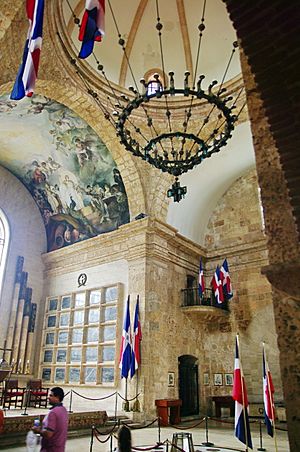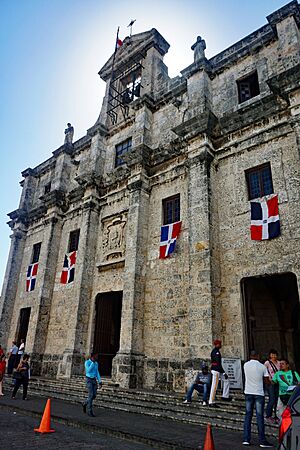National Pantheon of the Dominican Republic facts for kids
The National Pantheon is a very important building in the Dominican Republic. It was built a long time ago, between 1714 and 1746, by a Spanish architect named Geronimo Quezada y Garçon. At first, it was a church for the Jesuits. This beautiful building shows off a mix of old styles, like Neoclassic and Renaissance. Today, it's a special place where the most respected heroes and important people of the Dominican Republic are honored and laid to rest.
Quick facts for kids National Pantheon of the Dominican Republic |
|
|---|---|

Interior of the Pantheon
|
|
| Location | Santo Domingo, Dominican Republic |
| Built | 1714–1746 |
| Restored | 1956 |
| Restored by | Javier Borroso |
| Architect | Geronimo Quezada y Garçon |
| Architectural style(s) | Neoclassic-renaissance |
| Lua error in Module:Location_map at line 420: attempt to index field 'wikibase' (a nil value). | |
Contents
The Pantheon's Story
Early Uses of the Building
The Jesuits used this building for church services until 1767. After that, it had many different jobs! It was used as a place to store tobacco. Later, in 1860, it became the first theater in the Dominican Republic.
A group called "Amantes de las Letras" (Lovers of Letters) used it for plays. This theater, later known as La Republicana, operated until 1917. After its time as a theater, the building housed government offices until 1956.
Becoming a National Monument
In 1956, a Spanish architect named Javier Borroso helped change the building. He made it into a national mausoleum, which is a grand building for honoring important people. This was done by order of the leader at the time, Rafael Trujillo.
Trujillo originally wanted to be buried there himself. However, today the National Pantheon is where many of the country's most famous heroes are honored. This includes people who bravely stood up against Trujillo's rule.
Honored People in the Pantheon
This special place is the final resting spot for many important figures. They are remembered for their contributions to the Dominican Republic. Here are some of the notable people honored here:
- Francisco Gregorio Billini – A Dominican writer, teacher, and politician.
- Concepción Bona – A teacher who helped design the Dominican Republic flag.
- Pedro Francisco Bonó – A Dominican politician, thinker, and writer.
- Francisco Caamaño – A Dominican soldier and politician. He was president during the Civil War of 1965.
- Juan Bautista Cambiaso – An explorer, admiral, and sailor in the Dominican Navy.
- Antonio Duvergé – A Dominican general who fought in the Dominican War of Independence.
- Ulises Francisco Espaillat – A Dominican author and president.
- Fabio Fiallo – A Dominican writer, poet, politician, and diplomat.
- José María Cabral – A Dominican military leader and politician. He was the first Supreme Chief of the Dominican Republic.
- Jose Gabriel García – A Dominican military figure, historian, politician, and journalist.
- Francisco Henríquez y Carvajal – A doctor, lawyer, writer, educator, and president of the Dominican Republic.
- Pedro Henríquez Ureña – A Dominican essayist, philosopher, and literary critic.
- Gregorio Luperón – A Dominican military general and President.
- Eugenio María de Hostos – A Puerto Rican educator, philosopher, and advocate for Puerto Rican independence.
- José Núñez de Cáceres – A Dominican politician and writer. He was the only president of the Republic of Spanish Haiti.
- Emilio Prud'Homme – Known for writing the words to the Dominican national anthem.
- Gaspar Polanco – A Dominican military general and politician.
- Juan Sánchez Ramírez – A Dominican soldier who served as the Captain General of the modern Dominican Republic.
- José Rufino Reyes y Siancas – A Dominican composer. He created the music for the Dominican national anthem.
- Benigno Filomeno de Rojas – He served as the Head of State and President of the Dominican Republic.
- Pedro Santana – A Dominican military general and President.
- Socorro Sánchez del Rosario – A Dominican educator and journalist. She was the country's first feminist journalist.
- María Trinidad Sánchez – A Dominican freedom fighter and heroine of the Dominican War of Independence.
- Salomé Ureña – A Dominican poet and an early supporter of higher education for women.
See also
 In Spanish: Panteón de la Patria para niños
In Spanish: Panteón de la Patria para niños
- List of Jesuit sites


